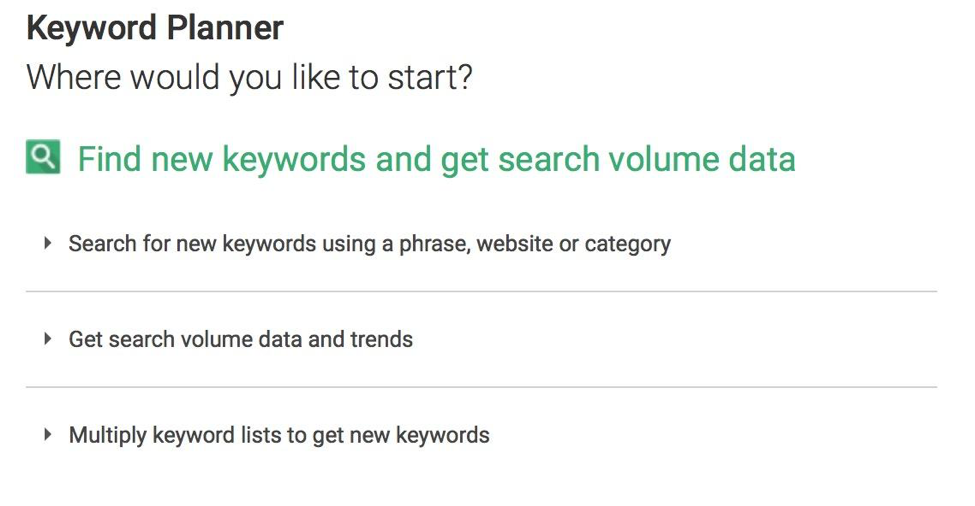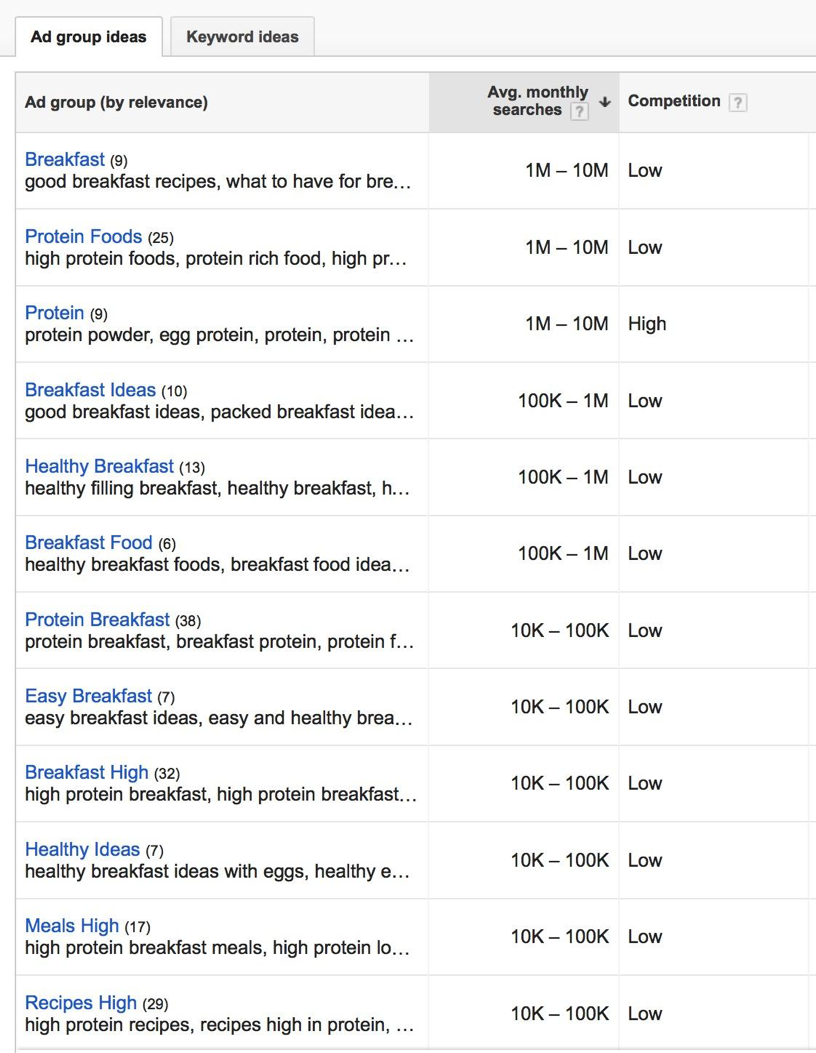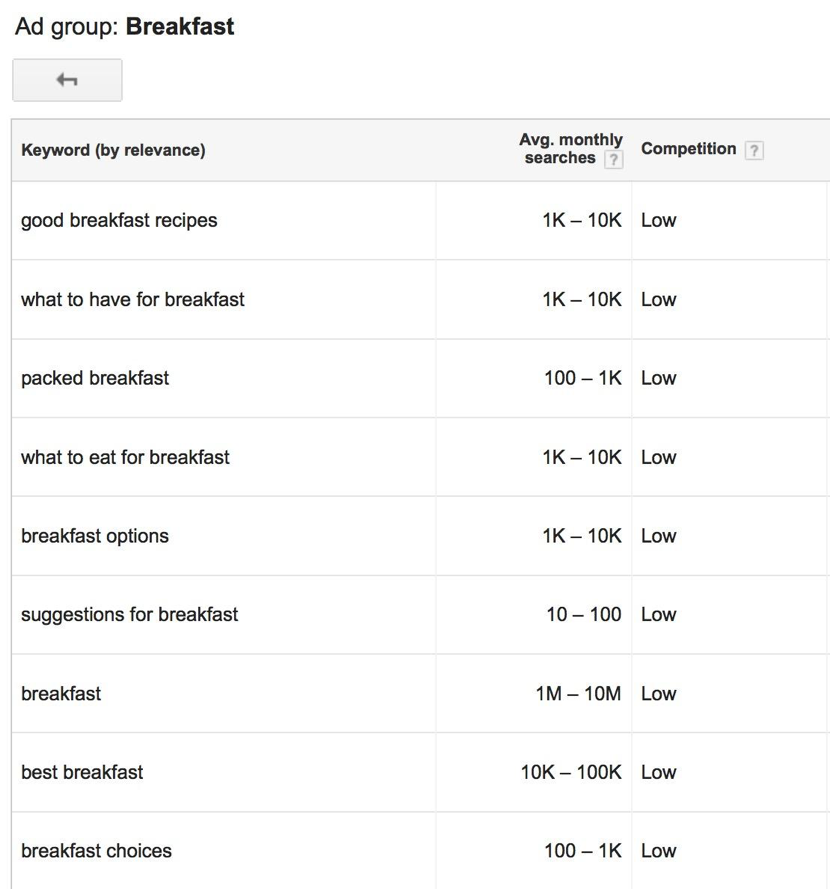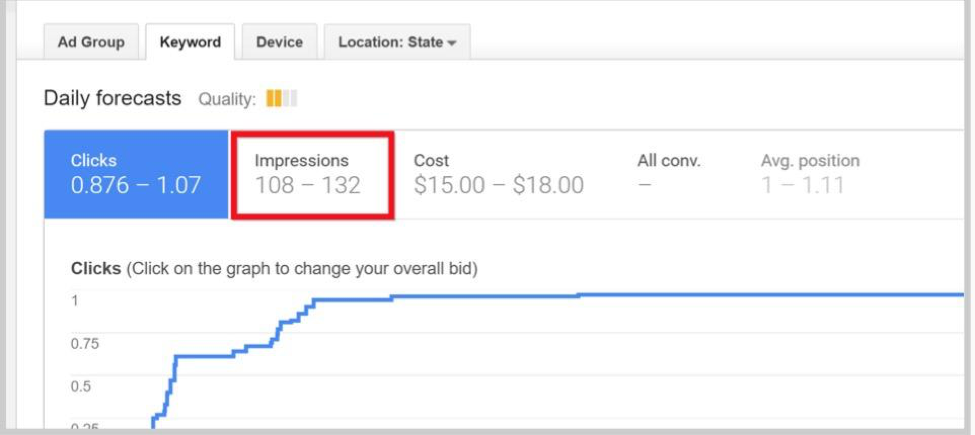
The Smart Guide to Keyword Research for Google’s Keyword Planner
When it comes to SEO, most of us talk about backlinks, authoritative content, Google algorithms and innovations such as RankBrain. These are extremely important search engine ranking factors; no one can deny their importance.
However, amidst all this discussion, we often tend to forget about the most important and fundamental element of SEO: keyword research.
The importance of keyword research has been somewhat nullified in the recent past. Search engine algorithms such as Google Hummingbird has led believe that keyword research doesn’t matter anymore.
If you believe that is the case, let us clarify the confusion. Without keyword research, there is no SEO.
We know it’s a bold claim, but that is the truth.
 Keyword Research is Vital to the Success of Your Business
Keyword Research is Vital to the Success of Your Business
You cannot expect your SEO campaign to be a success if you do not know which keywords to target.
If you do not identify keywords and phrases that your ideal customer uses to search for products or services in your industry, how can you expect them to find you?
If you do not know which keywords have the highest competition and which keywords have a moderate to low competition, how will you plan your strategy?
Keyword research — albeit how unsexy it appears to be — still forms the core foundation of search engine optimisation.
And make no mistake, it is here to stay.
Contents
- The Old, Outdated Way of Keyword Research
- The New Way of Researching Profitable Keywords
- Creating a List of Niche Topics
- Understanding Head, Body, and Long-Tail Keywords
- How to Use Google Keyword Planner to Find Profitable Keywords?
- Finding the Exact Search Volume Data for any Keyword
- Conclusion
Let’s start with our first chapter, which tells you the “wrong” method that you should stay away from…
 Chapter 1 — The Old, Outdated Way of Keyword Research
Chapter 1 — The Old, Outdated Way of Keyword Research
Keyword research is as much an art as it is science. And mastering it will give you the tools necessary to make any online business successful.
Once you the know the “right” methods and strategies, you can apply it to any online business you are running or helping with. The core concepts do not change. However, the problem with most SEO professionals is that they have been using the “wrong concepts” so far. That’s the main reason why so many of their online businesses fail and, in fact, never reach to the top of search engine positions.
This is how the keyword research process looks like for most SEO professionals out there.
- They brainstorm (a fancy word for ‘thinking’) a few keywords that they believe their target audience might be searching for in Google or other search engines. Note that they have no idea whether the keywords they shortlist are actually being used by their potential customers or not.
- Next, they use the Google Keyword Planner Tool and paste all those keywords in the tool.
- Out of the list that the Google Keyword Planner Tool provides, they pick out the keywords — based on their gut feelings — that they believe would work.
This is the most common way of doing keyword research. Incidentally, this is also a recipe for failure.
Keyword research is just that, “research”. It does not have to be based on guesses or gut feelings. This is the outdated method you need to stay away from.
But … which method should you use?
The second chapter explains the new method.
 Chapter 2 — The New Way of Researching Profitable Keywords
Chapter 2 — The New Way of Researching Profitable Keywords
The new way of researching keywords isn’t drastically different than the old one. We are still going to use the Google Keyword Planner in this method. However, this time, we are going to be smart about it.
The problem with the previous outdated method is that most people start their keyword research process with the Google Keyword Planner Tool. That’s the wrong approach.
The GKP tool does not know your customers as you do. The research process has to start from you.
Also, there are a couple more problems with starting with the GKP tool:
- Just like you, everybody else is doing that, too. It means that the Google Keyword Planner Tool would be feeding the same keywords to your competitors which it is feeding to you. As a result, you won’t be doing anything different than any of your competitors. How will you get ahead of them then?
- Second, when you enter just broad niche/keyword ideas in GKP, it only suggests very closely related keyword ideas. The Google Keyword Planner is an excellent tool, but it is still isn’t very good in generating fresh, new keyword ideas.
For example, when you think of “cricket” (the sports game), you think of several cool related ideas and keywords, e.g.,
- The English Cricket Board (ECB)
- Best Cricket catches
- Top batsmen in Cricket
- Sachin Tendulkar
- James Anderson
- Fielding in cricket
- Cricket vs. Baseball
Etc. etc.
However, when you feed the same keyword in Google Keyword Planner, it gives you this:
The Google Keyword Planner Tool would only give you ideas that are extremely related to the keyword you used. That’s not very helpful.
That’s where you need to find niche topics to help you find great keywords that your competitors wouldn’t. That’s how you get ahead.
Niche Topics — What are they?
In simple words, niche topics are the topic ideas that your target audience is most likely to be interested in. It does not have to be a very specific keyword (it rarely is). Instead, a niche topic is derived from a broad keyword and helps you find other more specific topics that your customers would be interested in.
As you can imagine, it is the same thing that the Google Keyword Planner fails to do for you.
Let’s take an example of a business that sells Taekwondo or Karate equipment. If you use the Google Keyword Planner, all it would give you are the following keywords:
You can see it is not a very helpful list.
However, if you dive deep into “niche topics”, you can identify topics that your customers would care about.
How do you begin identifying these niche topics and keyword ideas?
First, you start with a basic audience persona.
Creating a Buyer Persona
If you do not have a fictional persona of your ideal customer … what are you doing? Seriously?
It’s crucial. You can’t run an online business without it.
List every little detail of your ideal customer. Their age group, gender, preferences, interests, daily routines, etc. It will help you identify how they think and behave. The problems they are facing; the solutions they seek, and how your business can help them find those solutions.
Here is a simple template to fill in order to come up with a good buyer persona for your business:
- Age group:
- Gender:
- Approximate income:
- Willingness to shop online:
- Hobbies & Interests:
- Favourite social media networks:
- Things they usually struggle with:
- Goals they want to achieve:
- What can’t they find with your competitors:
Answer each of these questions to come up with a reasonably good buyer persona that you can work with.
Remember, it is the first step.
 Chapter 3 — Creating a List of Niche Topics
Chapter 3 — Creating a List of Niche Topics
Once you fully understand your buyer persona — the ideal customer you want to target — you will be able to come up with a list of niche topics.
For example, let’s continue our scenario for the karate equipment business.
As you saw previously, the Google Keyword Planner only spat out very tightly related keywords, which was not very helpful for us. However, by using the buyer persona, we can easily come up with things that a potential customer would be interested in.
Here are a few niche topics that a potential buyer of karate equipment would be interested in:
- How to execute a perfect roundhouse kick?
- How to tighten up your defence technique?
- 10 karate exercise tips to improve flexibility and strength?
- How to increase your stamina for a longer fight?
- Nutrition tips for karate players
You can come up with dozens of topics quite comfortably with this technique. As you can see, there is no way Google Keyword Planner could give you these keywords. That’s why it is such a valuable source of keywords and content ideas. It is totally unique because you are coming up with these ideas; it means your competitors wouldn’t be coming up with the exact same topics.
However, it is not all guesswork.
There are ways and tools that you can use to come up with proven ideas — ideas that you know for sure that other people (your target audience) is 100% interested in.
How?
Let’s see.
Using Forums for Creating a Niche Topic List
Forums are great. It is like having a group of like-minded people (your target audience) available to answer any of your questions 24 x 7. Ideally, you should know all the top forums in your industry. However, in case you do not know them, that list is always a quick search away.
Use Google to find relevant forums to your industry. You can easily find dozens of relevant forums with a search string like this:
Additionally, you can also try using keywords such as:
- “karate” + “forum”
- “karate” + “board”
Pro Tip: Most of the threads you find in an active forum would often be a completely new niche topic. You can use that overall list to increase your list of niche topics.
Dig deep into the most active threads, and you would find people discussing real problems and solutions in that industry. You would not only find tons of useful keyword ideas, but you would also be able to identify real problems and solutions that your target audience is struggling with.
Using Wikipedia for Creating a Niche Topic List
Wikipedia is another great resource for expanding your list of niche topics.
And it’s actually very simple to use it.
Just search for your main keyword and browse the “contents” section of the main page. Some of these niche topics are just pure gold that you won’t be able to find anywhere else.
Using Reddit for Creating a Niche Topic List
Reddit has the same formula as forums. The only difference is that Reddit is already a very active website, and you are likely to find dozens of SubReddits discussing the topic you are most interested in.
Based on the audience persona you create, you would find plenty of subreddits and threads where your target audience would hang out. Use the hobbies, interests, and goals sections of your audience persona to anticipate where you could find your potential customers.
Keep an eye out on those threads and identify potential niche topic ideas — just like you did with forums.
By applying all these techniques combined, you would come up with hundreds of powerful topics that your audience is actually interested in. Note that a major difference here is that these are not topics that are solely based on your gut feelings. These are proven ideas to work with.
 Chapter 4 — Understanding Head, Body, and Long-Tail Keywords
Chapter 4 — Understanding Head, Body, and Long-Tail Keywords
I’m assuming that you’d already know about head, body, and long-tail keywords. These are important concepts to understand before actually identifying which keywords to target.
In case you do not know, here is a brief explanation of each term:
Head Keywords
Head keywords are generally single-word keywords. They have an insane amount of search volume and an extremely high level of competition.
For example, “shoes”.
Although they are very tempting to go after, targeting head keywords is completely futile. This is not something you should be doing.
- First, it is almost impossible to rank high for a head keyword.
- Second, even if you do manage to rank (which is nearly impossible), you will not be able to convert your traffic into paying customers. Head keywords don’t have a high conversion rate.
Body Keywords
Body keywords are a relatively better option than “head keywords”. In fact, some SEO professionals believe they hit the sweet spot.
Technically, body keywords are 2-3 keyword phrases. They have a moderate search volume (around 2,000-3000 words) and have a low to medium level of competition.
For example, “red running shoes”.
If you find a good body keyword (depending on your industry), you should go after it.
Long-Tail Keywords
Long-tail keywords, as you can guess, are very long phrases. They usually have 4 or more than 4 keywords. More importantly, they have a very low level of competition and usually around 1,000 or less than 1,000 monthly search volume. They don’t appear at first glance to be the most tempting or sexiest keyword choices.
The interesting thing about long-tail keywords is that when combined with other similar keywords, long tails make up the majority of online searches.
For example, “red running shoes for men”.
Summarising the Different Types of Keywords
It can get confusing, so it is important to summarise all these types of keyword groups:
- Head keywords have large search volume and high competition. They are hard to rank and insanely difficult to convert. Leave them out.
- Body keywords hit a nice, sweet spot. Moderate volume, moderate level of competition, and a good commercial intent. If you can find a body keyword with moderate search volume and low competition, that’s ideal! Definitely go after them.
- Long-tail keywords are very interesting, these most often show great commercial intent, but have a very low search volume. You should go after them.
There is, however, one thing you need to understand about long-tail keywords. It’s a problem, actually.
Long-tail keywords often only have a few hundred search volume. So, in order to get a good amount of traffic, you would have to publish a large amount of content optimised around long-tail keywords.
That often puts content marketers at a risk of publishing thin content — shallow content that does not have a lot of information. Google does not like that. So make sure you have enough solid information to put out if you are going after long-tail keywords. Otherwise, it may backfire.
Let’s explore the functions of all three features.
Search for new keywords using a phrase, website or category
The first feature, ‘Search for new keywords using a phrase, website or category is used for finding broad keyword ideas once you feed the tool seed keywords. As discussed in the earlier section of this guide, the GKP tool would only provide closely related ideas.
The tip to use this feature is not to enter broad keywords as seeds. Instead, use “body keywords” or even “long-tail keywords” of around 1-3 keywords. Feeding super-competitive “head keywords” will not provide any useful information.
For example, instead of entering “nutrition”, try “low carb cookies” or “protein rich breakfast”.
Additionally, this feature also allows you to set specific targeting options.
 Chapter 5 — How to Use Google Keyword Planner to Find Profitable Keywords?
Chapter 5 — How to Use Google Keyword Planner to Find Profitable Keywords?
Now comes the actual part of using the Google Keyword Planner to find profitable keywords. As you can see, it is not the first place to start with — which you would do in the old, outdated method of keyword research.
Now that we already have a list of proven ideas and niche topics, Google Keyword Planner is in a better position to feed us useful information that we can use to our advantage.
There is one important point to note before we start.
The Google Keyword Planner tool is designed for Google AdWords advertisers. It is frequently used by search engine optimisers for search engine optimisation too, but the tool is primarily designed with paid advertisers in mind. Therefore, there would be quite a few features that won’t be useful for you. Additionally, you won’t be able to find certain pieces of information without an active AdWords campaign. But we will share a workaround.
Let’s begin.
Sign in to your Google account and start the Google Keyword Planner Tool.
You will find three different features on the main screen. These are the three features that most people would use.
Let’s explore the functions of all three features.
Search for new keywords using a phrase, website or category
The first feature, ‘Search for new keywords using a phrase, website or category is used for finding broad keyword ideas once you feed the tool seed keywords. As discussed in the earlier section of this guide, the GKP tool would only provide closely related ideas.
The tip to use this feature is not to enter broad keywords as seeds. Instead, use “body keywords” or even “long-tail keywords” of around 1-3 keywords. Feeding super-competitive “head keywords” will not provide any useful information.
For example, instead of entering “nutrition”, try “low carb cookies” or “protein rich breakfast”.
Additionally, this feature also allows you to set specific targeting options.
If you are doing research for generic, informative posts that aren’t bound by a physical location, you won’t have to tweak much in here. However, if you are doing keyword research for a local business, then you’d have to select the right language and country location.
Sometimes, playing with ‘Negative Keywords’ can also pay off. These are the keywords that you want the Google Keyword Planner to exclude. For instance, if you want to sell something, you might want to put the word ‘free’ in the negative keywords list.
If you look at the right side of the various targeting options, you’d see options to customise and filter your keyword search.
You can find only the relevant keywords by applying the right filters. For example, you can define that you are not interested in any keyword idea that has less than 1,000 monthly searches. The Google Keyword Planner will only show you the relevant keywords then, so you won’t have to manually filter them later.
Get search volume data and trends
This is a tool that is particularly helpful if you want to get search volume for keywords that you already have. Please note that this feature of GKP won’t provide you any new keyword ideas.
For using this tool, we suggest using the niche keyword list you brainstormed earlier. This would be a good idea to find how many of those keywords have enough search volume for you to go after.
The easiest way would be to upload a CSV file.
Again, you will be able to filter language, location, and negative keywords as earlier.
Multiply keyword lists to get new keyword ideas
The third tool in the Google Keyword Planner works a bit differently.
It takes groups of different keywords and mashes them together. As a result, it spits out hundreds and thousands of different combinations of keywords.
It is important to note that most of the keywords this feature gives will be gibberish and won’t make any sense. However, in my experience, it is still a good idea to carefully go through that list as it can often reveal some gems hidden among them.
This is one of those tools that is especially helpful for online stores and e-commerce businesses because it helps you identify different combinations of keywords that people use when they are looking for the products you sell, e.g., “best”, “free”, “cheap”, “review”, etc.
Browsing the Results
One big mistake that most search engine optimisers and keyword researchers do is that they spend most of the time in the ‘Keyword Ideas’ section, and not enough in the ‘Ad Group Ideas’. It’s a huge mistake, as there are often quite a few good keyword ideas in the ‘ad group’ section.
Let’s continue our example for the keyword ‘protein rich breakfast’. If we get new keyword ideas (by using the first feature of Google Keyword Planner), this is what the ‘keyword idea’ list shows.
As you can see, there are quite a few keywords that we can use right away. Feeding just a highly competitive “head keyword” wouldn’t have generated such a good result.
However, the story doesn’t end here.
If we jump on the ‘Ad Group Ideas’ section, you will see plenty more ideas that you can pursue.
You can see plenty of good keyword ideas even from this bird’s eye view, e.g.,
- High protein breakfast
- Healthy breakfast ideas with eggs
- Recipes high in protein
- Egg protein
- Breakfast food ideas
- What to have for breakfast
You should also jump into each of these ad groups to find the exact keywords and their search volume, competition, and commercial intent (CPC) etc.
Here is one of the ad groups as an example.
Plenty more ideas!
By now, you’d have easily jotted down at least 10-12 great keyword ideas that have the following qualities:
- Informative (people would search for it)
- Useful (you can create great content on it)
- High search volume (more traffic for your website)
- Low AdWords competition (potentially easy to rank in search engines)
- Body and long-tail keywords
And in case you have forgotten, that was just for ONE keyword.
You’d still have dozens more “niche keyword ideas” that brainstormed in the earlier chapters of this book.
Amazing, right?
By using all those niche keyword ideas with this method, you will end up with 500+ amazing keyword ideas with ideal qualities as mentioned above.
Now, here is another important trick to learn before you go out there and start researching keywords for your website.
 Chapter 6 — Finding the Exact Search Volume Data for any Keyword
Chapter 6 — Finding the Exact Search Volume Data for any Keyword
As you must have noticed, Google does not give you the exact search volume data anymore. Although it is still not a big issue, if you want the exact search volume data for each keyword, you can still find it with a neat little trick we are going to teach you. It will only add a couple of extra steps in your research, but you will have the exact search volume data for each keyword.
Find any keyword that you would like to get the exact search volume for and hit the blue ‘Add to Plan’ button.
Note: Don’t worry. This method works even if you do not have an active AdWords campaign.
You will be asked to place a bid. Place a ridiculously high bid, like £300. This is an important part, as with such a high bid, Google will assume that your keyword will appear on the first spot for all related searches for that keyword. Only after this assumption, we can get the actual data.
Google will then show you the number of “impressions” you’d get in this scenario.
This number indicates the number of people who would search for this keyword every day. Multiple this number by 30 (for 30 days), and you get the exact monthly search volume for each keyword.
 Conclusion
Conclusion
There are many more keyword tools that you can use, but GKP is one that can be highly effective if used correctly.
It is always a good idea to have as many keywords in your armoury as possible, but the exact methods specified in this guide should give you hundreds and thousands of keywords ideas without using any extra tool.
The Google Keyword Planner — if used correctly, is a goldmine of great keyword ideas. However, with the previous outdated method of keyword research, the Google Keyword Planner tool will not be able to provide any meaningful information and powerful set of keywords.
We hope you enjoyed the information in this book and that it will give your keyword research a new, refreshed direction. If you have any questions, please contact us. We’d be happy to help you.


















An excellent guide to Keyword Research, thank you Josh!